Back to the Index page
High Batts Reserve, June 14th 2000
For species lists, see below
 12 Members joined the trip to High Batts Nature Reserve near Ripon. We were shown round by the Warden, Colin Slator and his assistant. The weather was fairly kind and we had a most enjoyable day. Colin told us a great deal about the history of the reserve and the management carried out to encourage wildlife of all kinds. The area, which is part of the Norton Conyers Estate, lies on the floodplain of the River Ure; it has been managed as a nature reserve since 1973 and is now an SSSI. It has an interesting variety of habitats, underlain by river gravels and the magnesian limestone bedrock, which leads to a great diversity of plant life (see for instance the guelder rose bush, right). Colin made us green with envy when he said that in the spring part of the reserve was “yellow over” with Yellow Star of Bethlehem (Gagea lutea) which is a rare plant indeed in Ryedale!
12 Members joined the trip to High Batts Nature Reserve near Ripon. We were shown round by the Warden, Colin Slator and his assistant. The weather was fairly kind and we had a most enjoyable day. Colin told us a great deal about the history of the reserve and the management carried out to encourage wildlife of all kinds. The area, which is part of the Norton Conyers Estate, lies on the floodplain of the River Ure; it has been managed as a nature reserve since 1973 and is now an SSSI. It has an interesting variety of habitats, underlain by river gravels and the magnesian limestone bedrock, which leads to a great diversity of plant life (see for instance the guelder rose bush, right). Colin made us green with envy when he said that in the spring part of the reserve was “yellow over” with Yellow Star of Bethlehem (Gagea lutea) which is a rare plant indeed in Ryedale!

The reserve has several hides from which one can observe the birds, although there were not too many about when we visited. Unfortunately we also did not see many of the insects which frequent the reserve, especially dragonflies in the ponds which have been created for them. There are also numerous moths but we did not see them either...
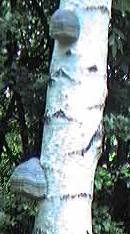 I do not have lists of all that was found, but we did record the following:
I do not have lists of all that was found, but we did record the following:
Birds
Members saw or heard:
Kingfisher, Chiffchaff, Willow warbler, Blackcap, Carrion Crow, Goosander,
Oystercatcher, Yellowhammer, Long-tailed Tit, Skylark, Garden Warbler,
Treecreeper, Song Thrush, Wren, Black-headed Gull, Great Spotted
Woodpecker, Robin, Wood Pigeon, Mistle Thrush, Swallow, Moorhen, Coot, Blue
Tit, House Martin, Mallard, Kestrel, Swift, ?Sand Martin and Common Gull.
Back to the Top
Plants
We saw 150 species, which I have divided into plants in bud, flower or fruit; plants represented by leaves only; trees & bushes; ferns and horsetails; and grasses and sedges. The lists for grasses and sedges include only those which are easily identifiable or notable.
I took a few photos (see below).

Tormentil |

Buckthorn (female flowers) |

Rockrose |
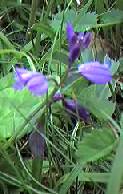
Milkwort |
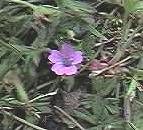
Cut-leaved Geranium |
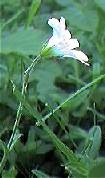
Field Mouse Ear |

Welted Thistle |
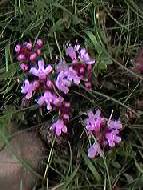
Wild Thyme |

Yellow Flag or Iris |
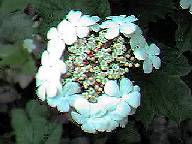
Guelder Rose |
|
|
Back to the Top
Plants in bud, flower or fruit
| English Name |
Latin Name |
| Avens, wood |
Geum urbanum |
| Bedstraw, marsh |
Galium palustre |
| Birdsfoot trefoil, common |
Lotus corniculatus |
| Bluebell |
Hyacinthoides non-scripta |
| Bramble |
Rubus fruticosus |
| Bugle |
Ajuga reptans |
| Bulrush |
Schoenoplectus lacustris |
| Burdock |
Arctium minus |
| Buttercup, creeping |
Ranunculus repens |
| Campion, bladder |
Silene vulgaris |
| Campion, red |
Silene dioica |
| Chickweed, common |
Stellaria media |
| Cleavers |
Galium aparine |
| Clover, white |
Trifolium repens |
| Clustered Bellflower |
Campanula glomerata |
| Comfrey, common |
Symphytum officinalis |
| Cow parsley |
Anthriscus sylvestris |
| Cranesbill, cut leaved |
Geranium dissectum |
| Cranesbill, dovesfoot |
Geranium molle |
| Cranesbill, meadow |
Geranium pratense |
| Crosswort |
Cruciata laevipes |
| Cuckoo flower or Milkmaid |
Cardamine pratensis |
| Daisy |
Bellis perennis |
| Dame’s violet |
Hesperis matronalis |
| Deadnettle, white |
Lamium album |
| Flax, fairy |
Linum catharticum |
| Forgetmenot, field |
Myosotis arvensis |
| Forgetmenot, tufted |
Myosotis laxa |
| Forgetmenot, wood |
Myosotis sylvatica |
| Ground elder |
Aegopodium podagraria |
| Hard Rush |
Juncus inflexus |
| Hawkweed, mouse eared |
Pilosella officinarum |
| Hedge Garlic or Jack by the Hedge |
Alliaria petiolata |
| Hedge mustard |
Sisymbrium officinalis |
| Hemlock |
Conium maculatum |
| Hogweed |
Heracleum sphondylium |
| Jointed Rush |
Juncus articulatus |
| Milkwort, common |
Polygala vulgaris |
| Mouse ear, common |
Cerastium fontanum |
| Mouse ear, field |
Cerastium arvense |
| Mugwort |
Artemesia vulgaris |
| Nettle, common |
Urtica dioica |
| Orchid, common spotted |
Dactylorhiza fuchsii |
| Parsley piert |
Aphanes arvensis |
| Pearlwort, procumbent or mossy |
Sagina procumbens |
| Pineapple weed |
Matricaria discoidea |
| Plantain, ribwort |
Plantago lanceolata |
| Pondweed |
Potamogeton sp |
| Poppy, common |
Papaver rhoeas |
| Ramsons |
Allium ursinum |
| Rockrose |
Helianthemum nummularium |
| Rose, burnet |
Rosa pimpinellifolia |
| Rose, dog |
Rosa canina |
| Salad Burnet |
Sanguisorba minor |
| Scarlet pimpernel |
Anagallis arvensis |
| Shepherd’s purse |
Capsella bursa-pastoris |
| Soft Rush |
Juncus effusus |
| Spearwort, lesser |
Ranunculus flammula |
| Speedwell, brooklime |
Veronica beccabunga |
| Speedwell, germander |
Veronica chamaedrys |
| Speedwell, heath |
Veronica officinalis |
| Speedwell, slender |
Veronica filiformis |
| Speedwell, wall |
Veronica arvensis |
| Spiked Water Milfoil |
Myriophyllum spicatum |
| Stitchwort, lesser |
Stellaria graminea |
| Stitchwort, wood |
Stellaria nemorum |
| Strawberry, barren |
Potentilla sterilis |
| Strawberry, wild |
Fragaria vesca |
| Thistle, welted |
Carduus crispus |
| Three nerved sandwort |
Moehringia trinerva |
| Thyme |
Thymus polytrichus |
| Thyme-leaved Sandwort |
Arenaria serpyllifolia |
| Trefoil, lesser |
Trifolium dubium |
| Waterlily, yellow |
Nuphar lutea |
| Wood Clubrush |
Scirpus sylvaticus |
| Yellow iris or Flag |
Iris pseudacorus |
| Yellow pimpernel |
Lysimachia nemorum |
| Number of Species: |
78 |
Back to Plants and the Top
Plants in leaf
| English Name |
Latin Name |
| Bellflower, greater |
Campanula latifolia |
| Bindweed, hedge |
Calystegia sepium |
| Butterbur |
Petasites hybridus |
| Centaury |
Centaurium erythraea |
| Cinquefoil, creeping |
Potentilla reptans |
| Cinquefoil, marsh [?] |
Potentilla palustris |
| Cowslip |
Primula veris |
| Dock, broad leaved |
Rumex obtusifolius |
| Dogs mercury |
Mercurialis perennis |
| Enchanters nightshade |
Circaea lutetiana |
| Figwort, common |
Scrophularia nodosa |
| Figwort, water |
Scrophularia auriculata |
| Fleabane |
Pulicaria dysenterica |
| Gypsywort |
Lycopus europaeus |
| Hop |
Humulus lupulus |
| Knapweed, common |
Centaurea nigra |
| Mallow, musk |
Malva moschata |
| Marjoram |
Origanum vulgare |
| Meadowsweet |
Filipendula ulmaria |
| Mint, corn |
Mentha arvensis |
| Mint, water [?] |
Mentha aquatIca |
| Old Man’s Beard |
Clematis vitalba |
| Primrose, common |
Primula vulgaris |
| Ragwort, common |
Senecio jacobea |
| St Johnswort, perforate |
Hypericum perforatum |
| Thistle, creeping |
Cirsium arvense |
| Thistle, spear |
Cirsium vulgare |
| Vetch, tufted |
Vicia cracca |
| Violet, hairy |
Viola hirta |
| Violet, sweet |
Viola odorata |
| Water plantain |
Alisma plantago-aquatica |
| Willowherb, great |
Epilobium hirsutum |
| Willowherb, rosebay or Fireweed |
Chamaenerion angustifolium |
| Wood sage |
Teucrium scorodonia |
| Yarrow |
Achillea millefolium |
| Number of Species: |
35 |
Back to Plants and the Top
Trees and Bushes
| English Name |
Latin Name |
| Alder |
Alnus glutinosa |
| Ash |
Fraxinus excelsior |
| Birch, silver |
Betula pendula |
| Bird cherry |
Prunus padus |
| Blackthorn |
Prunus spinosa |
| Buckthorn |
Rhamnus catharticus |
| Crab apple |
Malus sylvestris |
| Currant, red |
Ribes rubrum |
| Dogwood |
Cornus sanguinea |
| Elder |
Sambucus nigra |
| Elm, wych |
Ulmus glabra |
| Guelder rose |
Viburnum opulus |
| Hawthorn |
Crataegus monogyna |
| Hazel |
Corylus avellana |
| Hybrid Black Poplar |
Populus sp |
| Larch |
Larix sp |
| Maple, field |
Acer campestre |
| Spindle |
Euonymus europaeus |
| Sycamore |
Acer pseudoplatanus |
| Willow, crack |
Salix fragilis |
| Willow, Purple |
Salix purpurea |
| Willow, white |
Salix alba |
Number of Species: |
22 |
Back to Plants and the Top
Ferns and Horsetails
| English Name |
Latin Name |
| Bracken |
Pteridium aquilinum |
| Horsetail, Field |
Equisetum arvense |
| Horsetail, Marsh |
Equisetum palustre |
| Horsetail, Water |
Equisetum fluviatile |
| Male Fern |
Dryopteris filix-mas |
Number of Species: |
5 |
Back to Plants and the Top
Grasses and Sedges
| English Name |
Latin Name |
| Barren Brome |
Bromus sterilis (Anisantha sterilis) |
| Cocksfoot |
Dactylis glomerata |
| False Oat |
Arrhenatherum elatius |
| Meadow Grass, Rough |
Poa trivialis |
| Red Fescue |
Festuca rubra |
| Slender False Brome |
Brachypodium sylvaticum |
| Yorkshire Fog |
Holcus lanatus |
| Bladder Sedge [? not certainly identified] |
Carex vesicaria |
| Cyperus Sedge |
Carex pseudocyperus |
| Glaucous Sedge |
Carex flacca |
| Number of Species |
10 |
| Total Number of Species: |
150 |
Back to Plants and the Top
Vertebrates
Colin showed us a crested newt and a small toad (particularly finely marked with reddish stripes) which he found under a stone. They are pictured below on someone’s hand.

Small toad |
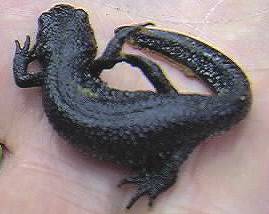
Great Crested Newt (small specimen...) |
All photos © copyright 2000 Gill & Adrian Smith
Back to the Top and Index page
© Ryedale Natural History Society 2000
Page last modified 5th July 2000
 12 Members joined the trip to High Batts Nature Reserve near Ripon. We were shown round by the Warden, Colin Slator and his assistant. The weather was fairly kind and we had a most enjoyable day. Colin told us a great deal about the history of the reserve and the management carried out to encourage wildlife of all kinds. The area, which is part of the Norton Conyers Estate, lies on the floodplain of the River Ure; it has been managed as a nature reserve since 1973 and is now an SSSI. It has an interesting variety of habitats, underlain by river gravels and the magnesian limestone bedrock, which leads to a great diversity of plant life (see for instance the guelder rose bush, right). Colin made us green with envy when he said that in the spring part of the reserve was “yellow over” with Yellow Star of Bethlehem (Gagea lutea) which is a rare plant indeed in Ryedale!
12 Members joined the trip to High Batts Nature Reserve near Ripon. We were shown round by the Warden, Colin Slator and his assistant. The weather was fairly kind and we had a most enjoyable day. Colin told us a great deal about the history of the reserve and the management carried out to encourage wildlife of all kinds. The area, which is part of the Norton Conyers Estate, lies on the floodplain of the River Ure; it has been managed as a nature reserve since 1973 and is now an SSSI. It has an interesting variety of habitats, underlain by river gravels and the magnesian limestone bedrock, which leads to a great diversity of plant life (see for instance the guelder rose bush, right). Colin made us green with envy when he said that in the spring part of the reserve was “yellow over” with Yellow Star of Bethlehem (Gagea lutea) which is a rare plant indeed in Ryedale!
 I do not have lists of all that was found, but we did record the following:
I do not have lists of all that was found, but we did record the following:











